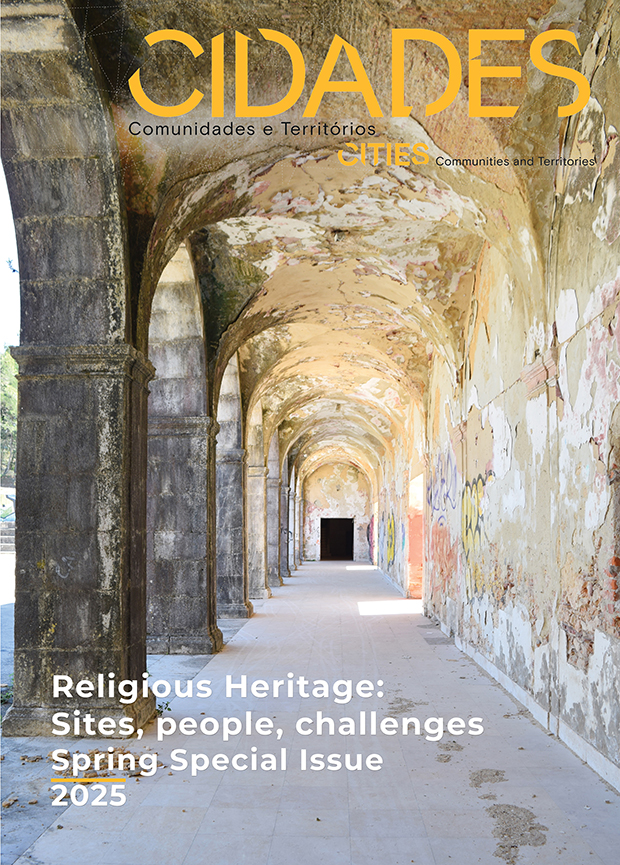Valorisation of the cultural heritage created by the living of religious orders
Keywords:
religious heritage, cultural valorisation, monastic lifeAbstract
This article explores the valorisation of the cultural heritage created by religious orders, focusing on the material and immaterial legacies preserved within these communities. It begins by highlighting the rich architectural, artistic, and liturgical heritage generated by religious orders over centuries, often intertwined with the unique spiritual and social values of the communities that produced them. The article underscores the importance of understanding how these religious assets - ranging from buildings and movable objects to archives and libraries - bear witness to the evolving religious practices and histories of monastic life. We propose to delve into the impact of the suppression of religious orders in the 19th and 20th centuries, which led to the fragmentation and dispersion of these invaluable resources. Despite challenges in tracking and preserving these elements, there should be renewed focus on their cultural valorisation through interdisciplinary research and modern technological tools. Special attention is given to the integration of archives, libraries, and museums, which can collectively enhance the historical narrative of religious communities. Additionally, the article examines the intersections of cultural heritage with gender, spirituality, and intercultural dialogue. It concludes by stressing the need for a comprehensive, collaborative approach to safeguard and reframe religious heritage as a vital cultural resource, contributing to both local and global historical understanding.
References
ACRI - Commisione per le Attività e i Beni Culturali (2021). Beni ecclesiastici di interesse culturale: ordinamento, conservazione, valorizzazione. Bologna: Il Mulino.
Allal-Chérif, O. (2022). Intelligent cathedrals: Using augmented reality, virtual reality, and artificial intelligence to provide an intense cultural, historical, and religious visitor experience. Technological Forecasting and Social Change, 178, 121604. https://doi.org/10.1016/j.techfore.2022.121604.
Bartolomei, L. (2018). Il patrimonio culturale dei monasteri femminili di vita contemplativa: peculiarità, presenza, prospettive. Culture e Fede. 26, 205-213
Bernardo de Claraval. (1997). Apologia para Guilherme, Abade: Texto latino da edição crítica e tradução (G. C. Dias, Trans.). Mediaevalia. Textos e Estudos, 11-12, 63-68.
Borges, A. M. (2009). Reais Hospitais Militares em Portugal (1640-1834). Coimbra: Imprensa da Universidade de Coimbra.
Campos, F. M. A. S. G. (2014). Bibliotecas de História: aspectos da posse e uso dos livros em instituições religiosas de Lisboa nos finais do século XVIII (PhD thesis, Faculdade de Ciências Sociais e Humanas, Universidade Nova de Lisboa).
Fusco Girard, L., Gravanuolo, A. (2018). Gli immobili ecclesiastici degli enti religioso: riuso e valorizzazione sociale. BDC - Bollettino del Centro Calza Bini - Università degli Studi di Napoli Federico II, 18. 237-246.
Giurgevich, L., Leitão, H. (2016). Clavis Bibliothecarum. Catálogos e inventários de livrarias de instituições religiosas em Portugal até 1834. Lisboa: Secretariado nacional para os bens culturais da Igreja.
Gomes, S.A. (2013). Monastic construction in medieval Portugal: some reflections. In A. S. Melo, M.C. Ribeiro, História da Construção - Arquiteturas e Técnicas Construtivas (pp. 245-266), Braga: CITCEM/LAMOP.
Levy, E. (2017). Jesuit Architecture Worldwide: A Culture of Corporate Invention. Companion to the History of Architecture, 1–33. https://doi.org/10.1002/9781118887226.wbcha013
Loparco, G. (2001). Gli archivi e i beni culturali della Chiesa nella formazione e nel ministero dei religiosi e delle religiose. Archiva Ecclesiae, 43-44, pp. 89-108.
Silva, L. (2009). A arquitectura dos conventos de clausura das clarissas em Portugal. PhD Thesis in Architecture, University of A Coruña.
Sousa. B. V. (dir) (2016) Ordens Religiosas em Portugal – Das Origens a Trento. Guia Histórico. Lisboa: Livros Horizonte, 3rd editon.
Sobral, C. (2007). Santo Agostinho em Aveiro: estudo de fontes. Ehumanista, Journal Of Iberian Studies, 8, 171-196. http://www.ehumanista.ucsb.edu/
Texeira, F. M. (2007). A arquitectura monástica e conventual feminina em Portugal, nos séculos XIII e XIV (PhD Thesis, Universidade do Algarve). Available at: http://hdl.handle.net/10400.1/479
Volzone, R. (2020). Architecture of the Soul. Legacy of the Eremitical Congregation of São Paulo da Serra de Ossa (PhD thesis, ISCTE-Instituto Universitário de Lisboa).
Volzone, R., and Fontes, J. L. (2020). The Portuguese eremitical Congregation of the Serra de Ossa: spatial analysis of the monastic settlements. Journal of Medieval Iberian Studies, 12:1, 84-105. https://doi.org/10.1080/17546559.2019.1652838.
Volzone, R., Fontes, J. L., and Martins, D. (eds.). (2022). Architectures of the Soul. Multidisciplinary approaches to the experiences and landscapes of seclusion and solitude. Lisbon: DINÂMIA’CET-Iscte, CHAIA-UÉ, IEM-NOVA FCSH, UCP-CEHR. https://doi.org/10.34632/9789895328741.
Volzone, R., and Fontes, J. L. (eds.). (2022). Architectures of the Soul. Diachronical and multidisciplinary readings. Lisbon: DINÂMIA’CET-Iscte, CHAIA-UÉ, IEM-NOVA FCSH, UCP-CEHR. https://doi.org/10.34619/wsvj-jfis.
Volzone, R., Fontes, J., and Carapinha, A. (2023). Towards the reconstruction of sacred medieval spatialities: multiscale analysis of the system of eremitical landscapes in Southern Portugal from historical records. Historical Archaeology, 57(2). https://doi.org/10.1007/s41636-023-00414-2.
Downloads
Published
Issue
Section
License
Copyright (c) 2025 Carlos Azevedo

This work is licensed under a Creative Commons Attribution-NonCommercial-NoDerivatives 4.0 International License.
Cidades, Comunidades e Territórios by DINÂMIA'CET-IUL is licensed under a Creative Commons Atribuição-Uso Não-Comercial-Proibição de realização de Obras Derivadas 4.0 Unported License.Permissions beyond the scope of this license may be available at mailto:cidades.dinamiacet@iscte.pt.






